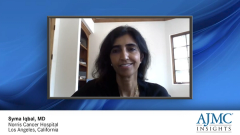
The Evolving Treatment Landscape of Upper GI and Esophageal Cancer
Laura Bobolts, PharmD, BCOP, and James M. Cleary, MD, PhD, explore the evolution of treatment for patients with upper GI and esophageal cancer, including first- and second-line treatment strategies for gastroesophageal cancer.
Episodes in this series

Laura Bobolts, PharmD, BCOP: The treatment landscape for upper GI [gastrointestinal] cancers, including esophageal, gastric, and gastroesophageal [GE] junction cancers, has evolved over the past 12 to 15 months. The biggest change we have seen is the incorporation of PD-1 inhibitors into the treatment landscape, with the recent approvals of pembrolizumab plus chemotherapy, nivolumab plus chemotherapy, and nivolumab plus ipilimumab by itself, a dual immune checkpoint inhibitor–based regimen. In addition, we have seen antibody-drug conjugates enter the market, with trastuzumab deruxtecan [Enhertu] being approved in the second line for HER2-positive gastric cancers. All in all, we’re seeing new targeted therapies enter the market in the upper GI cancer space.
James M. Cleary, MD, PhD: The treatment landscape has changed in a very positive way over the last year and a half in gastroesophageal cancer. There have been a couple of landmark trials that have allowed us to incorporate immunotherapy into the treatment of the vast majority of our patients.
The first study [focused on] patients with esophageal cancer, both squamous and adenocarcinoma, and GE junction adenocarcinomas to see if adding adjuvant immunotherapy, adjuvant PD-1–directed therapy with nivolumab, improves outcomes. We saw that when patients undergo standard-of-care chemoradiation and esophagectomy, adding immunotherapy after the esophagectomy doubled the time it takes for the cancer to come back. The community is incredibly excited about this. We’re still waiting for overall survival data, but we’re all optimistic that the trial is going to have a survival benefit. On the basis of these data, the FDA approved adjuvant nivolumab for the treatment of esophageal cancers and GE junction adenocarcinomas.
The other big change in the treatment of gastroesophageal cancer has been in metastatic gastroesophageal adenocarcinoma. I’ll talk in a second about the treatment of metastatic squamous cell cancers. With metastatic adenocarcinomas, in the first-line setting, we’d typically treat patients with FOLFOX [folinic acid, fluorouracil, oxaliplatin]. In patients who don’t have HER2 amplification, the CheckMate 649 study showed that the addition of nivolumab to FOLFOX improved outcomes. This was welcomed in the field. We have been looking for ways to use immunotherapy. The one caveat is that the addition of immunotherapy, nivolumab, to FOLFOX works best in cancers that have a PD-L1 CPS [combined positive score] of 5 or greater. We’ll talk a little later about patients who have a PD-L1 score of 5 or less, because that’s a little more controversial.
The one thing that everyone agrees on is that with patients with metastatic gastroesophageal adenocarcinoma, the standard of care is giving FOLFOX and PD-1–directed therapy in patients who have a HER2-negative tumor and a PD-L1 CPS of 5 or greater. In metastatic squamous cell esophageal cancer, the same results have come out. The standard of care for patients with metastatic squamous cell esophageal cancer is to treat with FOLFOX and the addition of PD-1–directed immunotherapy.
[As far as] the treatment strategies for patients with metastatic gastroesophageal adenocarcinoma, in the first-line setting, when a patient is HER2 negative and their PD-L1 CPS is 5 or greater, I treat them with FOLFOX and PD-1–directed immunotherapy. The other thing that has changed a lot in the last year has been in the treatment of patients with HER2-amplified gastroesophageal adenocarcinoma. We’d typically treat these patients with chemotherapy, FOLFOX or XELOX [capecitabine, oxaliplatin], combined with trastuzumab [Herceptin]. But the KEYNOTE-811 study showed that the addition of pembrolizumab to FOLFOX and Herceptin works even better. Now the standard of care for patients with HER2-amplified gastroesophageal adenocarcinoma in the first-line setting is to give FOLFOX, trastuzumab, and pembrolizumab.
In the second-line setting for metastatic gastroesophageal adenocarcinoma, the standard of care is ramucirumab with or without paclitaxel. This is something we’re hoping to improve on. In some instances, we do FOLFIRI [folinic acid, fluorouracil, irinotecan] as well. But by and large, in the HER2-negative population, we’re treating patients in the second-line setting with paclitaxel and ramucirumab, and then occasionally using FOLFIRI. What has been exciting is in the second-line setting for patients with HER2-amplified gastroesophageal cancer is that we’re using Enhertu. Enhertu is a drug that has gotten the whole oncology community excited because there have been wonderful results seen in breast cancer, and encouraging results seen in colon cancer and gastroesophageal cancer. In my HER2-amplified patients who have progressed on FOLFOX-Herceptin-pembrolizumab, I like to put them on Enhertu, the HER2 antibody-drug conjugate in the second line.
Transcript edited for clarity.
Newsletter
Stay ahead of policy, cost, and value—subscribe to AJMC for expert insights at the intersection of clinical care and health economics.










































